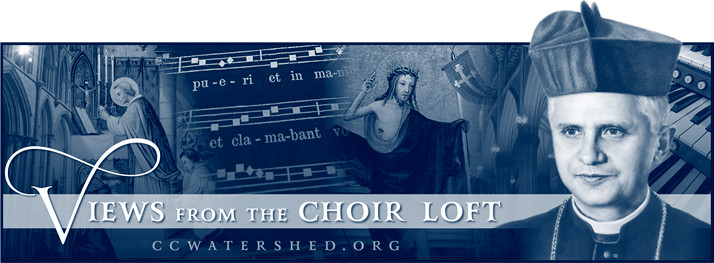
 OME CLAIM the darkest period for plainsong in Catholic churches was the 1980s, and it would be difficult to argue with them. Growing up in the late ’80s and early ’90s, I can assure you that my large (rich) parish was innocent of even the thought of Gregorian chant. During those dark years, several journals dealing with early music published articles with misguided titles like: “Which is more important in Gregorian chant: Words or Music?”
OME CLAIM the darkest period for plainsong in Catholic churches was the 1980s, and it would be difficult to argue with them. Growing up in the late ’80s and early ’90s, I can assure you that my large (rich) parish was innocent of even the thought of Gregorian chant. During those dark years, several journals dealing with early music published articles with misguided titles like: “Which is more important in Gregorian chant: Words or Music?”
These authors felt one must “win” and the other must “lose.” They were at a disadvantage because they only knew the laws of more recent composers—Baroque, Classical, and so forth—who treated the text a certain way. Trying to make sense out of plainsong, many concluded the words must win. Yet, had they looked more carefully, they would have discovered thousands of passages which don’t fit their a priori theory:
* * PDF Download • Demonstration on the Gregorian Tonic Accent
In other words, Gregorian composers often treated the text as a whole, not as individual syllables. Dom Gajard said it best in 1950:
“One does not compose in order to set every word to music, but in order to translate into music a single idea expressed in a number of words. In a musical phrase, each element is a part of the whole and must take its own place in that whole: for instance, the word coeli in SANCTUS IX, or the word Domini in the BENEDICTUS of Mass XI, and so forth. Here, the melodic line must be given first place, according to the ancient adage: Musica non subjacet regulis Donati.”
A student of Roger Wagner put it this way: “Gregorian rhythm is inherently musical in nature.”

MOST PLAINSONG SETTINGS now appearing in English favor the “Baroque method” of tonic accent treatment. In my opinion, that’s just fine—because plainsong examples can be found to support such an approach. (Remember, the Gregorian corpus is mammoth, and developed over a millennium.) However, I believe that as time goes on, composers who adapt Gregorian chant into the vernacular will begin to dig deeper into the authentic plainsong repertoire. A desire will form in their hearts to “steal” the mysterious, spiritual, sophisticated, unpredictable technique of the Gregorian composers. As the decades roll on, we will begin to see English settings which look more like the examples in that chart (see above).
I’m old enough to remember when composers were afraid to adapt Gregorian chant because the GIRM seemed to imply that approval by the local bishop is required. On 20 November 2012, the Bishops’ Liturgy Committee stated publicly what had been happening behind closed doors for half a century. Specifically, they said that—according to them—certain parts of the GIRM can be ignored. While I personally disagree with their interpretation, I’m glad that what’s been happening for 50 years has finally been acknowledged publicly.

